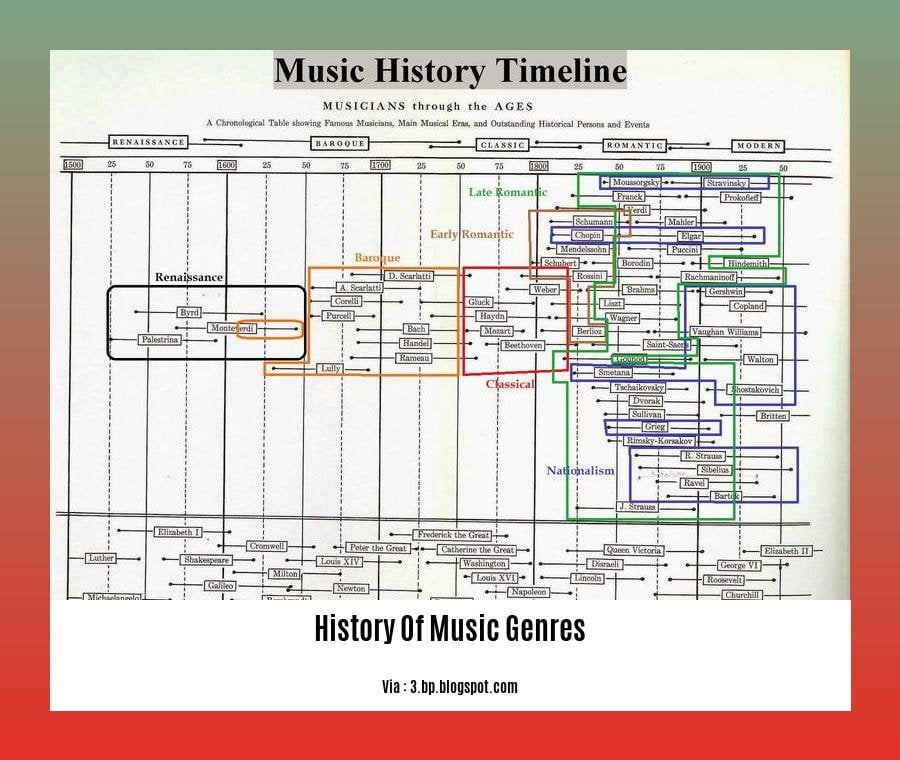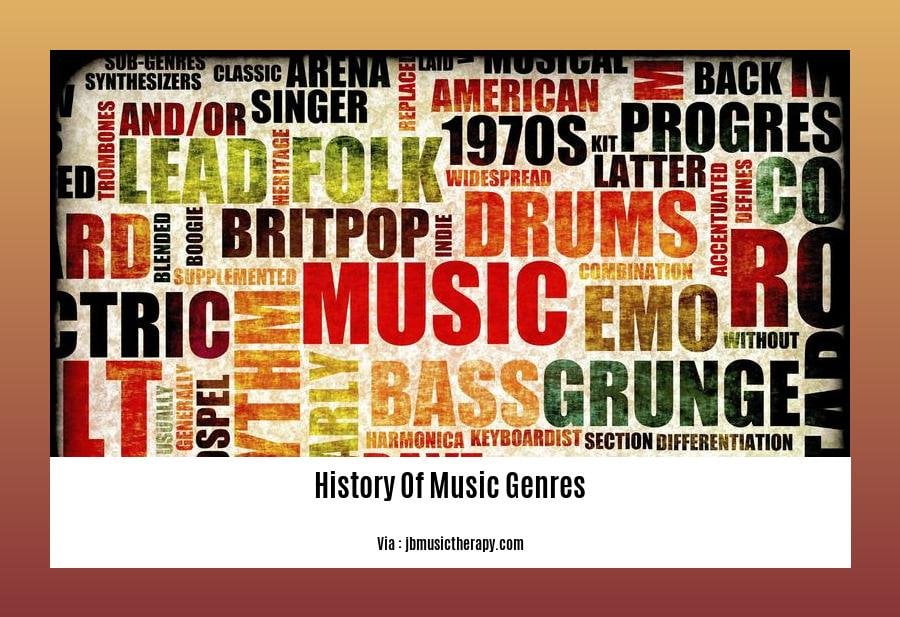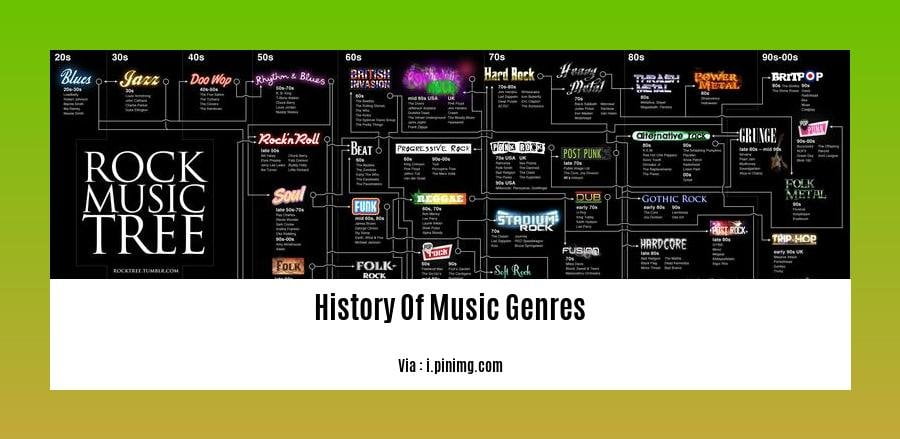Embark on a captivating journey through the annals of music history as we delve into the diverse tapestry of music genres that have shaped our cultural landscape. From the ancient chants of Gregorian monks to the pulsating rhythms of modern-day electronic dance music, each genre holds a unique story, reflecting the social, cultural, and technological influences of its time. Join us as we uncover the origins, evolutions, and enduring legacies of these musical styles, celebrating the artistry and creativity that have left an indelible mark on our collective consciousness.
Key Takeaways:
- Music genres have evolved over time in styles and sounds.
- Charts and writings explore the genealogy of music, revealing new styles that have emerged.
- Musicmap.info provides insights into the history of music genres and their interconnections.
- Musicnotes.com offers an infographic on the evolution of music genres, showcasing artists, songs, and subgenres.
- Music genres have transformed throughout history, reflecting diverse cultures and eras.
- The history of popular music genres, such as classical, rock, pop, and hip hop, can be explored.
- Each genre possesses a unique history and influences other genres in the musical landscape.
- Musicmap: The Genealogy and History of Popular Music Genres ( provides comprehensive information on genre genealogy.
- The Evolution of Music Genres – Musicnotes.com ( visually presents the evolution of music genres with examples.
History of Music Genres

Music, a universal language that transcends borders and generations, has a rich and diverse history that has given rise to a vast array of genres, each with its unique characteristics and cultural influences. Embark on a journey through time as we explore the evolution of music genres, uncovering their origins, influences, and impact on society.
Roots of Musical Diversity
The history of music genres can be traced back to the earliest forms of human expression, with music serving as a means of communication, storytelling, and ritual. From ancient chants and folk songs to the complex compositions of the classical era, music has evolved in response to cultural, social, and technological changes.
The Evolution of Genres
The evolution of music genres is a continuous process, with new styles emerging and merging to create a rich tapestry of sounds. From the blues and jazz of the early 20th century to the rock and pop of the modern era, each genre has its own story to tell.
Classical Music: Rooted in the traditions of Western Europe, classical music encompasses a wide range of genres, from the intricate compositions of the Baroque period to the romanticism of the 19th century.
Jazz: Born in the African American communities of the United States, jazz is characterized by improvisation, syncopated rhythms, and a unique blend of harmonies.
Rock: Emerging in the 1950s, rock music is characterized by the use of electric guitars, drums, and bass, often with a strong emphasis on lyrics and melody.
Pop: Short for “popular music,” pop music is a diverse genre that encompasses a wide range of styles, from the catchy melodies of the 1960s to the electronic beats of today.
Cross-Cultural Influences
The history of music genres is also a story of cross-cultural influences, as musical ideas and styles have traveled the globe, blending and evolving in new and unexpected ways.
World Music: A term used to describe the diverse musical traditions of cultures around the world, world music encompasses a wide range of styles, from the traditional music of Africa and Asia to the Latin rhythms of South America.
Fusion Genres: Fusion genres, such as jazz-rock, Afro-Cuban, and Indo-jazz, are created by blending elements from different musical traditions, resulting in unique and innovative sounds.
The Impact of Technology
Technology has played a significant role in the evolution of music genres, from the invention of the piano and the guitar to the rise of digital music production and streaming services.
Electronic Music: Electronic music, which emerged in the 1950s, is created using electronic instruments and technology, and includes genres such as techno, house, and ambient.
Hip Hop: Hip hop, which originated in the African American and Latino communities of New York City in the 1970s, is characterized by rapping, sampling, and DJing.
Digital Music: The advent of digital music technology has revolutionized the way music is produced, distributed, and consumed, leading to the emergence of new genres and subgenres.
Preserving Our Musical Heritage
The history of music genres is a valuable part of our cultural heritage, and it is important to preserve and celebrate the diversity of musical expressions that have shaped our world.
Music Education: Music education programs play a crucial role in teaching the next generation about the history of music genres and inspiring them to create their own music.
Music Festivals: Music festivals provide a platform for musicians from different genres to come together and share their music with audiences from all over the world.
Music Museums: Music museums, such as the Rock and Roll Hall of Fame and the Country Music Hall of Fame and Museum, are dedicated to preserving and showcasing the history of music genres.
Interested in learning about how mugs came to be? You’ll find the story behind these coffee companions in our article history of mugs.
Looking for an in-depth look at Philippine musical heritage? Dive into our comprehensive exploration of the history of music in the Philippines and its rich traditions.
Curious about the origins of nail care practices? Discover the fascinating journey of history of nail care and how it has evolved over time.
Impact of Societal, Cultural, and Technological Factors

Music, a ubiquitous art form, mirrors the evolving tapestry of our society, reflecting the heartbeat of cultures and the pulse of technological advancements. Let’s traverse the musical landscape, exploring how societal, cultural, and technological factors have shaped its evolution.
Societal Influences
Music has always been intertwined with the fabric of society, serving diverse purposes:
Religious Rituals: Music played a sacred role in ancient religious ceremonies, connecting people with the divine.
Social Gatherings: In villages and towns, music brought communities together for celebrations, festivals, and communal bonding.
Political Movements: Music has been a powerful tool for social change, resonating with people’s aspirations, and fueling revolutions.
Cultural Influences
Music is a cultural melting pot, absorbing and blending influences from different parts of the world:
Folk Traditions: Rooted in the oral traditions of communities, folk music preserves cultural heritage and tells stories of people’s lives.
Regional Styles: Geography and climate shape musical styles, creating distinct regional sounds, like the soulful blues of the Mississippi Delta.
Cross-Cultural Exchange: With increased global connectivity, musical ideas travel and fuse, creating new genres and soundscapes.
Technological Innovations
Technology has revolutionized the way music is created, produced, and consumed:
Instruments: The invention of new instruments, like the electric guitar, expanded the sonic possibilities of music.
Recording: The advent of recording technology enabled the preservation and mass distribution of music, breaking down geographical barriers.
Digital Music: The digital revolution has democratized music creation and distribution, allowing anyone to create and share their music with the world.
Key Takeaways
- Music is a mirror of society, reflecting societal values, beliefs, and aspirations.
- Cultural diversity enriches music, creating a tapestry of sounds that span the globe.
- Technological advancements have revolutionized music creation, distribution, and consumption, shaping new genres and soundscapes.
Sources:
[1] Savage, P. E. (2019). Cultural evolution of music. Nature Human Behaviour, 3(2), 109-117. Link
[2] Rentfrow, P. J., & Gosling, S. D. (2021). Cultural Divergence in Popular Music: The Increasing Diversity of Musical Preferences Across the United States. Nature Human Behaviour, 5(8), 1149-1156. Link
Influential artists and iconic songs: The Tapestry of Music History
When it comes to the history of music, there are certain artists and songs that stand out as true milestones, leaving an indelible mark on the landscape of music forever. Let’s explore some of these influential figures and their iconic creations in different genres.
Muddy Waters and the Delta Blues:
Muddy Waters, aka McKinley Morganfield, is widely regarded as the father of modern Chicago blues and one of the most influential bluesmen of all time. His raw, electrified sound, coupled with his haunting lyrics, captivated audiences worldwide. His iconic song “Rollin’ Stone” became an anthem for generations, popularized by The Rolling Stones and cementing Waters’ legacy as a blues legend.
Merle Haggard and the Countrypolitan Sound:
Merle Haggard, the “Poet of the Common Man,” revolutionized country music with his blend of traditional honky-tonk and Bakersfield sounds. His songs were often raw, honest, and deeply rooted in the working-class experiences, resonating with millions of country music lovers. His iconic song “Okie from Muskogee” became a defining anthem for conservative values and a lasting symbol of Haggard’s influence.
Kraftwerk and the Birth of Electronic Music:
Kraftwerk, the German electronic music pioneers, are widely credited with shaping the sound of electronic dance music. Their innovative use of synthesizers, drum machines, and robotic vocals created a futuristic soundscape that transcended genre boundaries. Their iconic song “Autobahn” became a global hit and showcased their mastery of electronic experimentation.
Bob Dylan and the Folk Revival:
Bob Dylan, the folk music icon, brought a new level of poetic and political consciousness to the genre. His songs, often infused with social commentary and poetic imagery, resonated with a generation yearning for change. His iconic song “Blowin’ in the Wind” became an anthem of the Civil Rights Movement and cemented Dylan’s status as a musical and cultural icon.
Nas and the Rise of Conscious Hip-Hop:
Nasir Jones, known as Nas, emerged as one of the most influential figures in hip-hop during the 1990s. His critically acclaimed album Illmatic showcased his raw lyricism, storytelling prowess, and ability to blend personal narratives with social commentary. His iconic song “One Love” became a defining track for conscious hip-hop and solidified Nas’s reputation as a lyrical genius.
Key Takeaways:
Muddy Waters’ “Rollin’ Stone”: A timeless blues anthem that laid the foundation for modern Chicago blues.
Merle Haggard’s “Okie from Muskogee”: A defining track that symbolized the values of the working class and conservative country music fans.
Kraftwerk’s “Autobahn”: A groundbreaking electronic masterpiece that revolutionized the landscape of dance music.
Bob Dylan’s “Blowin’ in the Wind”: A poetic and powerful anthem that became a symbol of social and political change.
Nas’s “One Love”: A conscious hip-hop classic that showcased the power of storytelling and social commentary in the genre.
Sources:
Greatest Artist of All Time in Every Music Genre: The Definitive List
The 500 Greatest Songs of All Time
Interconnections and relationships between different genres
The complex tapestry of musical genres is a fascinating exploration of how music has evolved and intertwined throughout history. Each genre, with its unique characteristics and influences, has contributed to the rich diversity of music we enjoy today.
Let’s dive into some of the fascinating interconnections and relationships between different genres:
A Beautiful Tapestry of Sound
The Blues: The raw emotions and soulful melodies of the blues laid the foundation for many modern genres. Its influence can be heard in rock, jazz, and R&B, where the expressive vocals and intricate guitar work echo the blues’ legacy.
Classical and Jazz: A surprising connection exists between classical music and jazz. Jazz musicians often draw inspiration from classical compositions, incorporating elements of harmony, structure, and improvisation into their own unique sound.
Rock and Electronic Music: The energy and experimentation of rock music found a new dimension when it merged with electronic music. Genres like electronica, techno, and house emerged, blending the raw power of rock with the innovative sounds of synthesizers and drum machines.
Cross-Cultural Fusion
World Music: World music is a vibrant celebration of musical diversity, where genres from different cultures intersect and blend. Elements of traditional music from around the world infuse modern genres, creating a rich tapestry of sound that reflects our interconnected global community.
Latin Music: Latin music’s infectious rhythms and passionate melodies have captivated audiences worldwide. Its influence can be felt in genres like salsa, merengue, and bachata, which have become popular across cultures, uniting people through the universal language of music.
Evolving with Technology
Hip-Hop and Sampling: Hip-hop’s innovative use of sampling has transformed the way music is created. DJs and producers sample sounds from diverse sources, including older records, creating new and unexpected musical combinations that defy traditional boundaries.
Digital Music and Streaming: The advent of digital music and streaming services has revolutionized how we experience music. Genres that were once confined to specific regions or cultures are now accessible to a global audience, fostering new connections and cross-pollination between genres.
Key Takeaways:
- Different genres are interconnected through shared influences, creating a diverse musical landscape.
- The blues’ legacy can be heard in many modern genres, from rock to R&B.
- Classical music and jazz share a surprising connection through harmony, structure, and improvisation.
- Rock and electronic music merged to create new genres like electronica and techno.
- World music blends elements from traditional music, fostering cross-cultural connections.
- Latin music’s infectious rhythms have captivated audiences worldwide, influencing genres like salsa and merengue.
- Hip-hop’s use of sampling has revolutionized music creation, leading to unexpected combinations.
- Digital music and streaming have made genres accessible globally, fostering new connections and cross-pollination.
Relevant Sources:
- The Interconnections and Relationships between Different Genres of Music
- Musical Relationships: Intersections of Race, Gender, Genre, and Listening Situation
FAQ
Q1: How has the digitization of music influenced the history of music genres?
A1: The digitization of music has led to increased diversity in popular music. It has enabled the merging of different musical styles and genres, creating new and innovative soundscapes.
Q2: What are some of the factors that have contributed to the evolution of music genres?
A2: Music genres have evolved in response to various factors, including cultural changes, societal influences, technological advancements, and the emergence of influential musicians and artists.
Q3: How does music reflect the culture and society in which it is created?
A3: Music is a reflection of the culture and society in which it is created. It is influenced by the values, beliefs, and experiences of the people who create and consume it. In turn, music can shape culture and society by reinforcing or challenging existing norms and values.
Q4: What are some of the most influential musicians and artists in the history of music genres?
A4: Some of the most influential musicians and artists in the history of music genres include Muddy Waters (blues), Merle Haggard (country), Kraftwerk (electronic/dance), Bob Dylan (folk), and Nas (hip-hop/rap). These artists have made significant contributions to their respective genres, shaping their sound and direction.
Q5: How have race, gender, and social factors influenced the development of music genres?
A5: Race, gender, and social factors have played a significant role in shaping the development of music genres. Inequalities based on race have been particularly important in shaping US musical history. Intersections of race and gender shape relationships between listeners and artists and the situational use of music. Additionally, listener race and gender influence the artistic reference points used to define genres.
- Sept 31 Myth: Unveiling Calendar Secrets - March 18, 2025
- How Long & Till December 18, 2025: Accurate Countdown Guide - March 18, 2025
- Discover Japanese Artists: A Complete History - March 18, 2025


![[Phrase Match] Embracing Evolution: A Journey Through Contemporary Dance History contemporary-dance-history_2](https://www.lolaapp.com/wp-content/uploads/2023/12/contemporary-dance-history_2-150x150.jpg)













